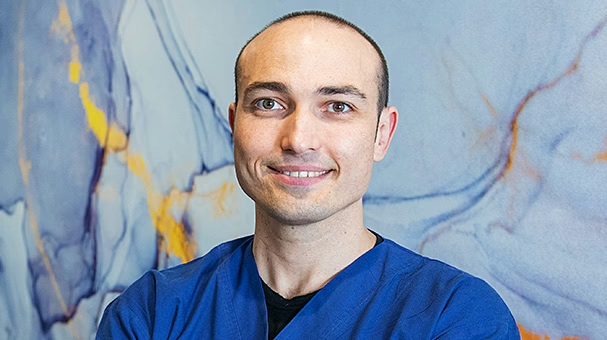Full-thickness corneal transplants
Full-thickness transplants (also called penetrating keratoplasty) are the most common corneal transplant procedure. If you suffer from keratoconus or corneal scarring and have exhausted all other forms of treatment, this procedure will most likely be recommended.
The cornea has five layers. Corneal graft surgery involves cutting through all five layers to remove the damaged or diseased section. The donor cornea, usually about the size of a small button, is then gently positioned into the opening and stitched into place. The stitches are removed at a later date.
Partial-thickness corneal transplants
If some of the corneal layers are undamaged or free from disease, a recent advance known as a partial thickness corneal transplant may be recommended. In this case, only the affected layers are removed. The surgeon does not cut through the entire thickness of the cornea.
These layers are replaced with layers of healthy donor tissue. Only a small area of the cornea is disturbed, usually resulting in a more stable outcome.2
There are two types of partial-thickness corneal transplants:
- Deep anterior lamellar transplant involves replacing all corneal layers except the deepest two. This type of cornea surgery can be used to treat keratoconus and scarring (e.g. due to injury or the herpes simplex virus) that spares the corneal endothelium.
- Endothelial layer transplant (endothelial keratoplasty) replaces the deepest layer of the cornea that has been damaged by disease or injury, leaving the front layers intact. This cornea surgery is commonly used to treat Fuchs’ endothelial dystrophy.
What to expect on the day of surgery
A corneal transplant is a day-surgery procedure and usually takes about two hours.
Patients are given a sedative to ensure that they remain relaxed throughout the procedure, and a local anaesthetic is used to numb the eye. The donor cornea will have already been tested to make sure it is healthy and free from disease or damage.
Your surgeon will use a microscope to perform the delicate cornea surgery. Sutures are required and are made of a material that is finer than a human hair.
Afterwards, you will be taken to a recovery room to allow the effect of the sedative to wear off. You will be discharged with eye drops and a protective eye patch. A post-operative check will be scheduled for the following day and then regularly thereafter.
Recovering from a corneal transplant
Following surgery, the donor tissue slowly fuses with your own tissue. Eyesight recovery is gradual and varies depending on the procedure. For penetrating keratoplasty, full recovery can take up to a year. This is mainly because of the time it takes for the tissue to heal properly and sutures removed.3
The newer techniques are less invasive and recovery is generally faster.2 Regular post-operative visits will allow your ophthalmologist to monitor your progress and identify any complications. Eye drops, and occasionally oral medication, will be required to prevent swelling, infection and pain for at least 6 months.
Visual recovery
Generally, corneal transplants are highly successful. Most people experience considerable improvement in vision.4 However, glasses or contact lenses are often still required.
Your surgeon may need to adjust the stitches to create a regular and round corneal shape. Stitches can be removed anywhere from 6 months to 3 years later. If the corneal shape is not ideal following stitch removal, then laser eye surgery (ASLA) may be used for further reshaping.
It’s important to understand that the corneal graft will not last forever. How long it lasts depends on the reason for the transplant. For example, a transplant in a patient with keratoconus usually lasts 15 to 20 years.
Risks of a corneal transplant
Corneal transplants have a high success rate. But, like any surgery, there are always risks. These may include:
- Primary failure of donor tissue
- Eye infection
- Rejection of the donor cornea
- Cataract development
- Problems with the stitches
- Corneal swelling
- Bleeding
Rejection occurs in about 20% of corneal transplants3 and can happen at any time, even years or decades later. Sometimes a new injury or illness causes the rejection. Fortunately, in most cases rejection can be controlled by medication if treated early enough.
If you notice redness or blurred vision that persists for longer than 24 hours, contact your surgeon immediately.
Future treatments
Corneal transplantation can be challenging to access due to the limited number of donor corneas available. However, Vision Eye Institute ophthalmologist Prof Gerard Sutton and his BIENCO consortium of experts from leading Australian institutions have developed world-first technology to bioengineer full-thickness corneas. This technology could remove the need to use corneal tissue from deceased donors.
Recently, BIENCO secured a $35 million grant from the Australian Government to move to its next phase of building a manufacturing and distribution facility in Sydney for bioengineered corneas. Read more about Prof Sutton’s research grant award and plans for the future of corneal transplantation here.
Corneal transplantation doctors
NSW
SA
VIC
References
1. Better Health Channel. Corneal transplantation and donation [Internet]. Melbourne (VIC): State of Victoria; [date unknown] [updated 2014; cited 2021 Jan 28]. Available from: https://www.betterhealth.vic.gov.au/health/ConditionsAndTreatments/corneal-transplantation-and-donation
2. Boynton et al. Evolving techniques in corneal transplantation. Curr Surg Rep. 2015 Feb 1; 3(2): http://link.springer.com/article/10.1007/s40137-014-0079-5/fulltext.html.
3. Boxer Wachler. Cornea transplants: What to expect from keratoplasty [Internet]. Irving (Texas): All About Vision; [date unknown] [updated 2017; cited 2021 Jan 28]. Available from: https://www.allaboutvision.com/conditions/cornea-transplant.htm
4. Brahma et al. Visual function after penetrating keratoplasty for keratoconus: a prospective longitudinal evaluation. Br J Ophthalmol. 2000 Jan;84(1):60-6. doi: 10.1136/bjo.84.1.60.
The information on this page is general in nature. All medical and surgical procedures have potential benefits and risks. Consult your ophthalmologist for specific medical advice.
Date last reviewed: 2025-02-28 | Date for next review: 2027-02-28




